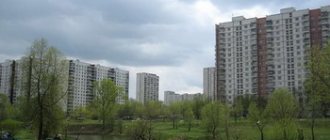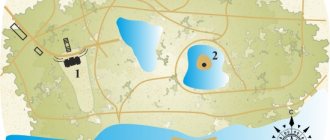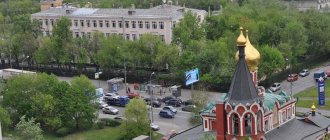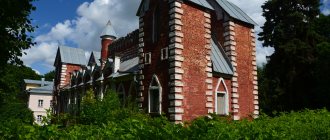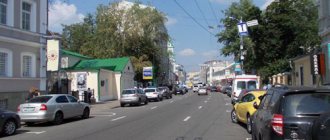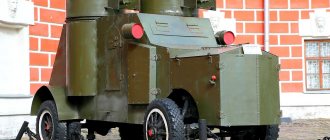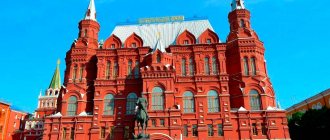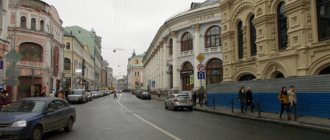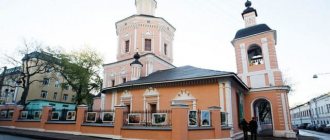Coordinates: 55°43′53″N 37°36′14″E / 55.73139 ° N W. 37.60389 ° E / 55.73139; 37.60389
Yakimanka district in Moscow Coat of arms of the Yakimanka district
Yakimanka district
(Russian: rayon Yakimanka) is a district of the Central Administrative Okrug of the federal city of Moscow, Russia. Population: 26,578 (2010 Census);[1]22,822 (2002 Census).[2]
It is named after the former church of Saint Joachim and Saint Anne. Yakimanka contains the western half of the historic Zamoskvorechye Square (the eastern half is administered as Zamoskvorechye proper), including the Tretyakov Gallery and the territories of Gorky Park and Neskuchny Garden. The border between the Yakimanka and Zamoskvorechye districts runs along Balchug Street and Bolshaya Ordynka Street (north of the Garden Ring), Korovy Val and Mytnaya Streets (south of the Garden Ring).
Story
Palace of the 17th century, Horde dead end. Writers' apartments in the background
Old Muscovy
This section is based on the book by P.V. Sytin “From the history of Moscow streets”, Moscow, 1948.
Territories on the right (southern) bank of the river. The Moscow River, now known as Zamoskvorechye, has been colonized since the 14th century. Two river crossings, to the west and east of the Kremlin wall, continued south to Kaluga and Serpukhov, and served as the main axes of the settlement. The western part of the Yakimanka district (between the Moskva River and Bolshaya Yakimanka Street) was regularly flooded, and thus its residential part was located within a 700-meter plot of land between Bolshaya Yakimanka and Bolshaya Ordynka streets (formerly Kaluzhskaya and Serpukhovskaya). roads). The floodplain was gradually built up in the nineteenth century, when the Babegorod Dam was completed, but even then the large field of the Crimean Bridge existed nearby until 1972, when the new building of the Tretyakov Gallery was built. The clover leaves on the district's coat of arms are a memory of these fields. (See Balchug to explain the development of the flood protection system on the Vodootvodny Canal, which separated the Bersenevka and Boloto areas from the mainland, and the history of the island.)
The lands south of the Moscow River, open to southern enemies, were regularly destroyed by raiders, notably Algirdas in 1366 and 1368, Tokhtamysh in 1382, Edigu in 1408, and the Tatar impostor Mazovsha in 1451. Permanent militarized settlements of Muscovites, called settlements, were created by Prince Vasily III at the beginning of the sixteenth century. A fortified line on the site of the current Garden Ring was built in 1591–1592. Theodore I. The Church of Saints Joachim and Saint Anne at 13 Bolshaya Yakimanka, which gives the area its name, was originally built in 1493 and later rebuilt and then destroyed by the Soviet government (see 19th century photo).[3]
The Yakimanka district has a diverse and rapidly changing ethnic and social composition:
- Constant presence of Tatara since the 14th century; Ordynka Street is named after the Golden Horde (in Russian, Orda
). Chernigovsky Lane is named in memory of Prince Mikhail Chernigovsky, who was killed by the Horde and buried in this area. - A settlement of foreign mercenaries of the 16th and 17th centuries, hired by Vasily III, Ivan the Terrible, and the early Romanovs.
- A 17th-century settlement of former Polish prisoners of war who remained in Moscow after the Time of Troubles, known as Babi Gorodok (Babi Gorodok, "women's town").
- Settlement of court interpreters ( Tolmachi
), who dealt with foreign guests (now Tolmachevsky Lane). - Settlements of the 16th/17th centuries. Cossacks (current Cossack Lanes) and Streltsy, dispersed after the Streltsovsky Uprising of 1698 (Pyzhevsky Lane, name of Streltsy Colonel Bogdan Pyzhov;[4] former Griboedovsky Lane[5]).
- Golutvin Sloboda, belonging to the Kolomna Golutvin Monastery (now Golutvinsky Lanes)
- Manufacturers of Sloboda barrels ( Kadashi
, Kadashevsky Lane). - Mint workers (Staromonetny Lane).
18th century
The century was preceded by mass executions by Streltsy. On September 30, 1698, Peter I hanged 36 soldiers at the Serpukhov Gate, 36 at the Kaluga Gate, etc., physically destroying the human core of the settlement system. By 1720, all Streltsov troops were disbanded. At the same time, artisans lost their business when the royal court moved to St. Petersburg. The patchwork settlement system of Zamoskvorechye fell apart, and social diversity subsided in the 18th century. Bolshaya Yakimanka remained a quiet street of single-family houses, many of which still farm in the floodplains; Wealthy merchants lived on Bolshaya Ordynka. Zamoskvorechye merchant
became the slogan of the ultra-conservative, bearded, pious archetype, the subject of Alexander Ostrovsky's play.
Even the richest of them lived in one-story country-style houses on spacious lots, some of which survive to this day. The areas on the outskirts of the city where Peter hanged his soldiers were occupied by grain warehouses and market squares, marked by the names of the streets Zhitnaya ("wheat") and Mytnaya ("tax"). Bolshaya Ordynka, 16, one of the surviving historical houses
Yakimanka was formed as an administrative district in 1782, when Catherine II divided Moscow into 20 police districts. In particular, Zamoskvorechye was divided between the Yakimansky and Pyatnitsky police stations.
Another development began at the end of the century on Kaluga Road beyond the Garden Ring (which at that time was a city rampart rather than a garden or street). On the modern territory of Gorky Park and Neskuchny Garden, between the Kaluga Road and the Moscow River, there were country houses of the Golitsyn, Demidov, Trubetskoy, Stroganov and later Orlov families. In 1793, Prince Dmitry Golitsyn bequeathed 900 thousand rubles for the construction of the first free state hospital in Moscow. A project supported by the Empress Dowager. Maria Feodorovna, completed in 1796–1802. Matvey Kazakov. Even though the Golitsyn family owned land nearby, the hospital was built on Stroganov family land. The construction of the hospital on the Kaluga Road continued into the next century. Today these hospitals belong to the Yakimanka district and are known as the First City
(First City).
19th century
This section is based on “Moscow at the turn of the century” [Moscow builders at the turn of the century]
[6]
Former British Embassy in the Swamp, facing the Kremlin, originally the mansion of Gustav Liszt Offices of the Golutvinskaya Sloboda, converted factories of the 19th century The
fire of 1812 engulfed the entire territory, with the exception of a few blocks at the southern tip of Bolshaya Yakimanka and the Kazakov hospital (which housed both Russian , and French troops). Construction of the Babegorod Dam and cleaning of the Vodootvodny Canal in the 1830s. The risk of flooding decreased, but land remained cheap. This led to the sustainable industrialization of Zamoskvorechye. For example, Gustav List founded his first metalworking factory in Boloto, directly opposite the Kremlin (his mansion, also in Boloto, later housed the British Embassy).
While most of Yakimanka remained a traditional low-rise shopping district, in Golutvin and Bersenevka (Golutvin was the birthplace of Pavel Ryabushinsky). Most of them have now been converted into office space, and the Red October Chocolate Factory (originally Einem) is planned to be converted in the near future. Hotels for business people were built nearby on Boloto and Balchug.
In 1896, a power station was built in the city. Zamoskvorechye (MOGES-1, the oldest existing power plant). The second power station, built specifically for the tram network, arose in the Yakimanka area, also in Bersenevka, and operates today. Since that time, the main tenants on Balchug Island.
The late nineteenth century was also a time of philanthropy and social experimentation. The Tretyakov Gallery, which began as the Pavel Tretyakov private collection of the 1850s, opened to the public in 1892. The existing building, with a façade designed by Apollinary Vasnetsov, was completed in 1899–1904. Pavel Tretyakov also financed the construction and operation of free housing for widows and children of Russian artists, located north of the Gallery.
Morozov Hospital, the city's first children's surgical hospital, opened in 1896 as a two-room Red Cross clinic. The Morozov family financed the construction of the existing two-story house on Bolshaya Polyanka. Another free hospital was run by the Marfo-Mariinsky Convent. Finally, city and private philanthropists also provided low-cost or free housing; the largest public housing projects began in the 1890s in the Swamp. The most famous of these projects, the Bakhrushinsky Free Apartments (1898-1900, Sofiyskaya embankment, 26),[7] now houses Rosneft's headquarters.
Modern history
Tretyakov Gallery, recently expanded
In 1922, the Bolshevik In Zamoskvorechye, the authorities closed and looted 22 churches, including the churches of Joachim and Anna, the churches of St. Maron, G. Gregory of Nyssa and others; then the Church of St. John the Warrior remained the only functioning church on Yakimanka. St. Joachim and St. Anne were demolished in 1933.[8] However, compared to other areas, the Joseph Stalin era brought very little damage to Yakimanka; it seemed that the area was abandoned.
In the 20s of the last century, the old Wine and Salt Yard on Bersenevka was replaced by the House on the Embankment; further south, Moscow's first cooperative residential building was completed in 1926. The development of Gorky Park began in 1923 with the holding of the first All-Russian Agricultural Exhibition; in 1928 the fair was reopened as a public park. The existing Stalinist entrance arch was added later in the 1950s.
The Moscow General Plan of 1935 provided for the completion of the Boulevard Ring through Zamoskvorechye, which was not done. The only trace of this project is the 1937 Writers' House opposite the Tretyakov House (expanded in the 1950s and 2000s); It was home to such elite writers as Evgeny Petrov of Ilf and Petrov Slava, Boris Pasternak, and Konstantin Paustovsky.[9] Similar majestic Stalinist buildings were planned along the entire length of the new route, but were cancelled.
The most important result of Stalin's projects was the completion of 1932–1938. Channel named after Moscow: floods have ceased to be a threat to the Yakimansk lowland. The banks of the rivers, which used to change every season, were firmly filled with granite; The entire center of the Bridges over the Moscow River and the Vodootvodny Canal were rebuilt to six to eight lanes.
Major destruction of Yakimanka occurred in Leonid Brezhnevpora. The western side of Bolshaya Yakimanka was rebuilt in the multi-story style typical of that time. Similar structures appeared on Polyanka Street, both in the form of infill and block projects. This was followed by the facadeist “reconstruction” of the 1990-2000s and new high-rise buildings such as the 15-story Copernicus construction. However, the city refused to build the avant-garde towers designed by Eric van Egeraat.[10]
Location: Moscow, Central Administrative District, Yakimanka
The new building is being built in Yakimanka, one of the most prestigious areas of Zamoskvorechye. The area was largely rebuilt during the Soviet years, but many old mansions have survived here. Since the 90s, the construction of modern residential complexes has been underway, mainly on the former territories of factories and factories. Thanks to this history, Yakimanka looks like an open-air museum: ancient temples and merchant houses coexist with examples of industrial design and luxury new buildings.
The Titul residential building is bordered on three sides by Soviet and pre-revolutionary residential buildings. The tallest building nearby is the 10-story elite residential complex “Onegin” on the other side of the alley.
How to get there by car and public transport
Several metro stations are located very close to the new building. The closest of them is “Polyanka” on the Serpukhovsko-Timiryazevskaya line, 200 meters away. The Oktyabrskaya metro station on the Circle Line is 1 kilometer away.
The most convenient transport routes for motorists are the Garden Ring and st. Big Yakimanka. From Bolshaya Yakimanka there is an exit to 2nd Khvostov Lane, from where entry to the underground parking lot of the club house “Title on Yakimanka” will be organized.
Rating 10/10. The house is located in a quiet center, with good cultural and social infrastructure. Here are all the amenities of the center of Moscow.
Famous buildings, cultural and educational sites
Bell tower of the St. Sophia Church in Moscow Church of the Resurrection of Christ in Kadashi
Museums
- Tretyakov Gallery
- Tretyakov Gallery exhibition hall on Krymsky Val, next to it is a sculpture park
- Art Museum Vasily Tropinin and his contemporaries (Shchetinsky, 10)
- Averky Kirillov's estate in Bersenevka (by appointment)
- House on the embankment museum www.museum.ru (by appointment)
- Marat Gelman gallery (Malaya Polyanka, 7/7)
Churches
- Marfo-Mariinsky Convent (1908–1912, architect: Alexey Shchusev, Bolshaya Ordynka, 34)
- Church of the Assumption (1695–1697, Bolshaya Polyanka, 37) www.pravoslavie.ru
- Church of the Iberian Icon of the Virgin Mary at the Children's Hospital (1896–1901, Bolshaya Polyanka, 20) www.pravoslavie.ru
- Church of the Icon of the Virgin Mary, Joy in Sorrow (1831–1836, architect: Joseph Bove) www.pravoslavie.ru
- Church of the Resurrection in Kadashi (2nd Kadashevsky 7-14) www.pravoslavie.ru
- Church of St. Sophia in Sadovniki (1682–1686, bell tower: 1862–1868, Sofiyskaya embankment, 32)
- Church of St. Catherine (1766–1767, architect: Karl Blank, Bolshaya Ordynka, 60/2) www.pravoslavie.ru
- Church of St. Gregory of Nyssa (1668–1679, Bolshaya Polyanka, 29A) www.pravoslavie.ru
- Church of John the Warrior (1704–1717, Bolshaya Yakimanka, 46) www.pravoslavie.ru
- Church of St. Maron the hermit in Malysh Gorodok
, former Polish Settlement (1727–1730, Bolshaya Yakimanka 32-2) www.pravoslavie.ru - Church of Saints Michael of Chernigov and Feodor (1675, Chernigovsky, 3) www.pravoslavie.ru
- (1656–1657, Bersenevskaya embankment, 18)
- Church of St. Nicholas the Wonderworker in Tolmachi (Maly Tolmachevsky, 9) www.pravoslavie.ru
- Church of the Holy Trinity on Shabolovka (1885–1895, Shabolovka, 21)
- Church of the First City Hospital (Leninsky Prospekt,
Theaters
- Variety Theater in House on the Embankment
Memorial buildings
- Embassy of France, former Igumnov House, 1888–1895 (www.ambafrance.ru, www.rian.ru, o-moskve.narod.ru)
- One-story house on Bolshaya Yakimanka, 8, remains of the old Golutvinskaya Sloboda
- House of Writers (Lavrushinsky Lane, opposite the Tretyakov Gallery)
Current prices in Titul residential complex as of 03/03/2021
| Apartment type | Price per apartment | Area, m2 | Price per m2, ₽ |
| open plan | from 34 million rub. | 62–128 | from 548 thousand |
Similar offers
Project declaration on the advertised website https://rozarossa.ru/. JSC Zubovskaya, 7. Due date: 2nd quarter 2021
Advertising
- from RUB 30.6 million
- Park of Culture
Elite apartment complex in the Central Administrative District. Swimming pool, spa area and restaurant on the ground floor. 24-hour service: breakfast at the appointed hour, cleaning, dry cleaning. Designer finishing from an Italian designer.
Project declaration on the advertised website https://kuznetsky12.ru/. Capital Project LLC - KM. Due date: IV quarter 2021
Advertising
- from 60 million rubles.
- Kuznetsky Bridge
Apartments and penthouses in premium surroundings. Nearby are the Bolshoi and Maly theaters, RAMT, Operetta Theater and the New Stage of the Bolshoi Theater. 1 km to the Kremlin, exquisite design of the entrance groups, shopping gallery on the ground floor.
Project declaration on the advertised website https://www.ingrad.ru/projects/foriver/. LLC SZ Simonovskaya. Due date: IV quarter 2023
Advertising
- from 14.8 million rubles.
- Avtozavodskaya
Danilovsky district of Moscow. 2.5 km to the Garden Ring. Near the House of Music, Lomonosov School, Simonov Monastery. Its own embankment with a pedestrian boulevard and bicycle paths. Unique layouts. Maximum discounts apply in March.
Recommendations
- Federal State Statistics Service of Russia (2011). “All-Russian Population Census 2010. Volume 1" [All-Russian Population Census 2010, vol. 1]. All-Russian Population Census 2010 [All-Russian Population Census 2010]
(in Russian). Federal State Statistics Service. - Federal State Statistics Service of Russia (May 21, 2004). > [Population of Russia, its federal districts, federal subjects, districts, urban settlements, rural settlements - administrative centers, rural settlements with a population of more than 3000 people] (XLS). All-Russian Population Census of 2002 [All-Russian Population Census of 2002]
(in Russian). - I.K. Kondratyev, The Hoary Antiquity of Moscow
(Moscow: Citadel, 1997, original 1893), p. 402, 595. - Nina Mikhailovna Moleva, Moscow is the capital
(Olma Media Group, 2003: ISBN 5-224-04274-7), paragraph 171. - PYZHEVSKY lane.
- Moscow: “O-Master”, 2001 (ISBN 5-9207-0001-7).
- https://gctm.ru/museum/bakhrushin/
- Russian: Official documents 1922 mir.voskres.ru
- “From the history of Moscow lanes”, M., 1997
- Russian: “Russian Avangard” as “Moscow style”, Izvestia, 04/15/2004. www.gif.ru
- "Main Archived April 6, 2013, at WebCite." Interstate Aviation Committee. Retrieved June 24, 2010 “119017, Moscow, Russia st. Bolshaya Ordynka, 22/2/1" Address in Russian Archived April 6, 2013, in WebCite: 119017, Moscow, Russia Bolshaya Ordynka st., 22/2/1
- “Federal Penitentiary Service Archived November 25, 2011 Wayback Machine. "Russian Government. Retrieved October 5, 2011." Address: 119991 Moscow, Zhitnaya street, 14 "
Construction technology. Architecture
The house is being built using monolithic brick technology. This method of construction is very fast, allows you to avoid seams and joints, provide good thermal insulation and subsequently carry out any redevelopment in the apartment or combine several apartments into blocks.
The style of the project combines classicism and Western modernism, so the building will look strict and without frills. The ventilated facades feature copper and Jurassic marble, which is known for its rare beauty thanks to inclusions of seaweed, sponges and corals. Panoramic windows and balcony doors will be decorated with wood-aluminum profiles, and exits to the roof on the terraces will be decorated with translucent structures on steel posts.
In total, the building has 6 floors and 18 apartments; on the underground floor there is a parking lot for 24 cars and technical rooms. The total area of residential premises is 2,266.67 square meters. m. The ceiling height on the first floor is 4.2 m, the ceilings in apartments from the second to fifth floors are 3.45 m, and in the penthouses of the top floor - 3.9 m.
Architectural concept and landscaping
Particular attention is paid to the privacy and safety of future residents. Video monitoring will be installed at street entrances - both for the lobby and for entrances to offices, parking, street entrance to the basement, as well as in designated roof areas. There will be IP intercom panels and exit buttons at the entrances to the building, and subscriber intercoms in each apartment. The concierge will have access to the intercom system.
Particular attention is paid to the privacy and safety of future residents. Video monitoring will be installed at street entrances - both for the lobby and for entrances to offices, parking, street entrance to the basement, as well as in designated roof areas. There will be IP intercom panels and exit buttons at the entrances to the building, and subscriber intercoms in each apartment. The concierge will have access to the intercom system.
Automation of entrance lighting is provided. Ventilation in apartments, control of carbon dioxide concentration in parking lots, drainage and fire protection will be automatic. An individual heating point will be installed to heat the house. There are no plans for significant landscaping of the site, but a lawn with an area of 56.6 square meters will be laid out. m.
Entrance groups and halls
The residential area will have a large lobby with a concierge desk and access to the staircases and elevators. The total area of the lobby is 67 square meters. m. There will also be a stroller area of 11 square meters. m. There will also be separate entrances to offices - from the street.
Rating 10/10. Strict architecture, large windows, construction using monolithic technology. A separate plus is for the significant automation of engineering systems and the full accessibility of the building for the disabled.
Ecological situation
Yakimanka is not one of the most polluted areas of the Central Administrative District, because it is located a little away from the largest transport routes of the center. At the same time, both traffic jams on Sadovoy, Third Transport Ring and Leninsky Prospekt, as well as navigation along the Moscow River, contribute to air pollution. The only industrial facility preserved here is the Udarnitsa confectionery factory (located approximately 2 km from the residential complex); it is not among the objects of increased environmental danger.
Green zones significantly improve the ecological situation: Gorky Park, Neskuchny Garden, courtyard parks, and the Vorobyovy Gory nature reserve with an area of more than 1,300 square meters. km.
Green zones significantly improve the ecological situation: Gorky Park, Neskuchny Garden, courtyard parks, and the Vorobyovy Gory nature reserve with an area of more than 1,300 square meters. km.
Conditions for purchasing housing: sales start expected
So far, the apartments of the elite Titul building on Yakimanka have not gone on sale. It is expected that they can be purchased under an equity participation agreement (DPA).
Developer sales office
The sales office of a residential building is located near the construction site, on Serebryanicheskaya Embankment, possession 7, building 11. Before the start of sales, here you can find out all the details about the future house.
Current promotions and news
Rating: 10/10. Sales have not yet started. The house meets the legal requirements for shared construction projects.
Temples on Bolshaya Polyanka
The name of one of the main streets of Zamoskvorechye, Bolshaya Polyanka, given at the end of the 18th century, recalls the fields that were here in ancient times.
The Church of Gregory of Neocaesarea in Derbitsy was erected according to a vow by Moscow Prince Vasily II (he was freed from Tatar captivity on November 17, 1445, on the day of memory of this saint). The stone church in Derbitsy (“above the ravines”) was built in the 17th century.
Its tiled decoration is believed to have been made by the famous Belarusian potter S. I Polubes. Icons belonging to the brush of the famous royal master S. Ushakov are currently in the Tretyakov Gallery. In the 19th century, the northern aisle of the Bogolyubskaya Mother of God was built in Empire pseudo-Gothic forms.
Having reached the Church of the Assumption in Cossack Sloboda (No. 37), cross Polyanka and head to 1st Khvostov Lane. A noticeable house in the new Russian style (No. 5) was built in the 1990s.
